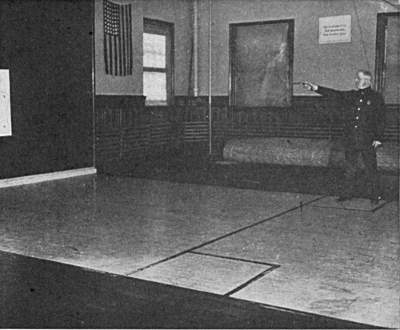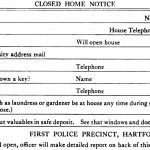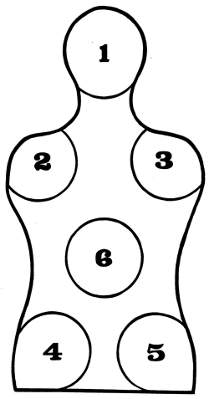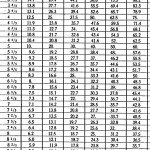The following information on target shooting for police officers comes from Section 41 of Shooting by J. Henry FitzGerald. Shooting is also available to purchase in print.
By Captain Edward J. Langrish
As a diversion from the serious work of the officer when on duty, he may turn to the more pleasant branch of revolver work,—target shooting. This is a very profitable pastime for the officer because, while it may not teach him the art of quick draw, it does teach him to accurately place his shots and to safely handle firearms.
The benefits derived from a trip to Camp Perry may better be understood by the officer who is fortunate enough to make the trip. At this camp is a police school maintained by the government with capable instructors who teach jiu-jitsu, the proper handling of tear gas, target shooting and, in fact, many branches valuable in police work.

There is an individual running-man police revolver match for police officers only. This match has developed into a team match with five men on a team. The running-man match is fired on the Colt Silhouette target at fifty yards. The target appears from cover and travels across the field at right angles to the shooter. It travels about twenty-three yards in five seconds, then disappears again. The officers are to fire three shots at the target on its first trip across and two shots on the return trip. Each shot counts that strikes in the black figure in a match of this kind. In shooting a match of this kind it is better to lead about three inches from the left elbow of the silhouette and on the return trip aim for the elbow of the arm with hand in the pocket. This kind of shooting is just the kind that the police want to get used to as it teaches the officer to shoot at a moving object.
Another very fine match is the bobbing surprise target match. The police officer walks out on to the field with his revolver cocked and in raised pistol position. The target is operated from a control pit back of the shooter at various distances and different angles. The limit of distance is sixty yards away and the nearer the target is to the shooter the less of the body of the target is exposed. Five targets are fired at in a match and the target is exposed for three seconds for each shot. The object is to aim at the center of the figure and to use all the time possible to ease off the trigger and not jerk it. The police officer must keep walking until the target is exposed, then stop walking to fire the shot.

The target shooting at the police school is at the same distance as in the regular police matches and the practice obtained here will condition the officers for the big matches. The Police Individual Match is fired under the following condition: ten shots at fifty yards on a Standard American target, ten minutes allowed for the ten shots; ten shots each five in twenty seconds at twenty-five yards on the Standard American fifty-yard target with ten and nine ring black; ten shots each five in ten seconds at twenty-five yards with the same target. In the Police Team Match all shooting is at twenty-five yards timed the same as the individual match and the twenty-five yard target is used in all three stages.
The time is very important and only by constant practice may the officer learn to use the time allowed to within one second. For this I use the Eastman Photographic Timer shown in another section, and instruct my men in its use. The author of this book, whom I have known for many years, is very good at guessing his time; in fact, I have timed him in many matches to as near as two-fifths of a second of the allowed time. This is accomplished by practice and dry shooting.
The best practice for winter is the Telegraph Match. These matches are shot on twelve-yard, police targets as furnished by the Colt’s Patent Fire Arms Company and these targets must be signed by the captains of each team and exchanged by them. It costs very little to conduct these matches for each team shoots on its own range and telegraphs the score after the match is completed. A member of a local revolver club may referee the match and sign the targets as a witness. The practice obtained in these matches is of great assistance to the officer in the coming outdoor matches at Perry or elsewhere. I have seen the old, cool, and collected officer, such as Sergeant J. H. Young of Portland, Oregon, stand on the firing line allowing nothing to interfere with a score up to his average or better, while the young officer who is making his first trip away from his home range will become over-anxious and will work himself into a state which will surely lower his scores. It is not a good practice to watch the different score boards when shooting in a match.
For several years at Camp Perry we have heard much discussion in regard to gadgets, or fitting the space between rear of trigger guard and front of grip with plastic wood, metal, etc. I favor plastic wood for my own revolver and the picture of a revolver so changed will appear elsewhere in this book (Section 6). I believe in my own case it is an advantage, especially in ten second work for it allows me to cock the hammer straight back and the trigger finger lays in a more direct line with the trigger, also the revolver comes back to the same position each time.

Captain Langrish’s Police Target
The police target invented by Captain Edward J. Langrish of the Hartford (Connecticut) Police Department is a wonderful target for police shooting. It teaches both speed and accuracy and the placing of the shots. I would advise every police department to use this target at least part of the time as it has a value for police shooting that is covered by no other target on the market, namely the placing of six shots in the circles from one to six. This teaches the officer to place every shot he fires accurately.

It is a pleasure to hold the stop watch on Captain Langrish and note the speed with which he can make a perfect score on this target,—six perfect hits at twelve yards in three to four and two-fifths seconds, double action. It may be seen from this time that the requirements of the scoring chart may easily be accomplished.
—The Author
Manufactured by
Case, Lockwood & Brainerd,
Hartford, Conn.
